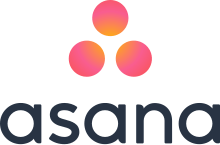Asana (software)
 | |
| Private | |
| Industry | Task management |
| Founded | San Francisco, California (2008) |
| Founder | Dustin Moskovitz and Justin Rosenstein |
| Headquarters | San Francisco, CA, United States |
Number of employees | 130 |
| Website |
asana |
Asana (/əˈsɑːnə/) is a web and mobile application designed to help teams track their work. It was founded in 2008 by Facebook co-founder Dustin Moskovitz and ex-engineer Justin Rosenstein, who both worked on improving the productivity of employees at Facebook.[1]
Company history
Moskovitz and Rosenstein left Facebook in 2008[2] to start Asana (named after a Sanskrit word meaning “yoga pose”[3]), which officially launched out of beta in November 2011.[4] The company announced that they had closed a $1.2 million angel round in the spring of 2011 from investors including Ron Conway, Peter Thiel, Mitch Kapor, Owen van Natta, Sean Parker, and former Facebook Director of Mobile Jed Stremel, followed by a $9 million USD Series A round in investment led by Benchmark Capital in late November 2011.[5] On July 23, 2012, Asana announced a new round of funding — Peter Thiel and Founders Fund, along with existing investors Benchmark, Andreessen-Horowitz, and Mitch Kapor, have invested $28 million in Asana; Thiel also joined Asana's Board of Directors. According to a New York Times article and someone briefed on the funding, the investors valued the company at $280 million.[6]
Some of Asana's high-profile clients include Airbnb, Dropbox, Disqus, Foursquare, Pinterest, Stripe, Aimia, General Electric, Samsung, Harvard University, Tesla Motors, NASA, and Uber.[7]
Product
Asana is web based software-as-a-service designed to improve team collaboration. It focuses on allowing users to manage projects and tasks online without the use of email.
Each team can create a workspace. Workspaces contain projects, and projects contain tasks. In each task, users can add notes, comments, attachments, and tags. Users can follow projects and tasks and, when the state of a project or task changes, followers get updates about the changes in their inboxes.
In May 2013, Asana launched Organizations, which enables companies to adopt Asana at enterprise scale. Organizations added an Asana Team Browser, a user dashboard, employee auto-join and IT administration abilities related to provisioning and permissions.[8]
In January 2015 Asana released its native Android app.[9]
Post-email application
In June 2012, Asana announced a new feature called Inbox that aims to help teams minimize the use of email. As one step towards building a “post-email application”,[10] Asana’s Inbox shows “updates to tasks, comments, due date changes, and other status updates people would normally reserve for email.”[11]
API
In April 2012, Asana released its API to third-party developers. Asana is integrated with productivity tools including Dropbox, Evernote, Google Drive, Harvest, Instagantt, Jira, Zendesk, and DigiSpoke.[12]
See also
References
- ↑ Guynn, Jessica (2 November 2011). "Facebook co-founder Dustin Moskovitz unveils new company, Asana". Los Angeles Times.
- ↑ Guynn, Jessica (3 October 2008). "Facebook co-founder Dustin Moskovitz leaves for start-up". Los Angeles Times.
- ↑ Vance, Ashlee (2 November 2011). "Asana: Dustin and Justin's Quest for Flow". BusinessWeek.
- ↑ Guynn, Jessica (2 November 2011). "Facebook co-founder Dustin Moskovitz unveils new company, Asana". Los Angeles Times.
- ↑ Schonfeld, Erick (24 November 2009). "Facebook Co-Founder Dustin Moskovitz Raises $9 million For New Collaboration Startup, Asana". TechCrunch.
- ↑ Cain Miller (23 July 2012). "Asana Raises Money to Save the World by Saving Time". The New York Times.
- ↑ "Asana: Prominent Customers". Retrieved 27 August 2016.
- ↑ Hardy, Quentin (1 May 2013). "Re-Re-engineering the Corporation". NewYorkTimes.
- ↑ "Asana ditches HTML5 for its first native Android app". Jan 20, 2015.
- ↑ O'Dell, Jolie (27 June 2012). "Death to email! And meetings, too. Asana's new inbox takes aim at "work about work"". VentureBeat.
- ↑ Hamburger, Ellis (27 June 2012). "With big Asana update, Facebook co-founder Moskovitz wants to kill email". The Verge.
- ↑ "The tools you use, integrated with Asana".